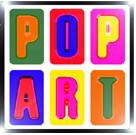
Pop Art is a twentieth century art movement. It is perhaps one of the best known movements in modern art because of its techniques and imagery are based in consumerism and popular culture. Beginning in the late 1950s, these concepts were juxtaposed and exploited as a reaction against the seriousness of Abstract Expressionism. Instead of abstract imagery, Pop Art toyed with the convention of reproducing everyday objects and popular images. Pop artists employed images of popular culture drawn from the cinema, television, advertising, comics and packaging. Its artists strove to blur the distinction between fine art and commercial or advertising art. It also transformed 'kitsch' art and elements of 'bad taste' into respected art and 'good taste'. Pop artists such as Roy Lichtenstein and Andy Warhol attempted to "fuse elements of popular and high culture to erase the boundaries between the two." In doing so, they created an artistic common ground for the artist and the layman.
Though it began in the 1950s, the Pop Art style persisted through the 1960s and into the 1970s. It developed primarily in North America and Great Britain. In the US, it was strongly influenced by the wealth and prosperity that followed World War II. Its artists responded with sarcasm and concern to the nation's consumer society. To reflect the manufactured and consumerist aspects of the modern world Pop artists employed techniques of sign painting, commercial art and mass production. The major Pop artists create unique and personal styles, yet the common sensibility was brittle, mocking and narcissistic.
Neo-dada
A section of Pop art, Neo-dada was strong in the 1960s. It was a follow up to Dada because Neo-dadists took objects and products taken from everyday life to form new artistic structures with them. The technique of raising used objects to the category of a work of art demanded a review of the American consumer society. Like Dada, Pop Art was opposed to the classical, the exclusive and the pretentious in art. The Pop artists borrowed inspiration from Marcel Duchamp's "ready-mades".
Assemblage
Assemblage is a technique used extensively by Pop artists. It allows for the combination of many different elements in a single picture. In Pop art, assemblage's objective is to create unexpected combinations and juxtapositions. It provided a medium for Pop's strong use of popular culture, printed ephemera, advertising and packaging.
Andy Warhol
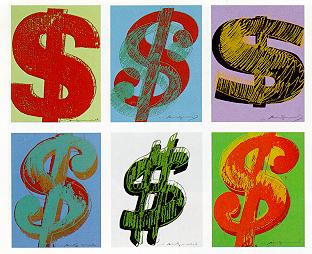 |
Andy Warhol is synonymous
with Pop art. He transformed contemporary art by
employing mass-production techniques to create works. He
helped to change the distinction between art and popular
culture. He is most famous for his exploitation of
popular or advertising objects (soup cans) and for his
portraits of stars and Hollywood icons. He is quoted
saying "Everything is beautiful. Pop is
everything." However, apart from showing everything
beautiful, Warhol used his art to make statements against
the consumerism of his (and our) times and the violent
American society. The Dollar Sign images are an example of Warhol's preference for symbols over objects. They are supposed to represent how the art system is linked to the commercial marketplace. And to criticize the consumerism and materialism. This theme of consumerism runs through most Pop Art. One critic writes that "the image should remind the viewer that art is judged by its dollar value, art represents money on the wall." This piece is also an example of his use of symbols to make strong, controversial statements. |
| Andy Warhol,
Self Portrait, 1986 Warhol created many interesting portraits of important personalities. The iconic image of Marilyn Monroe was partly created by Warhol's portrait. |
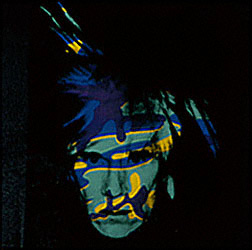 |
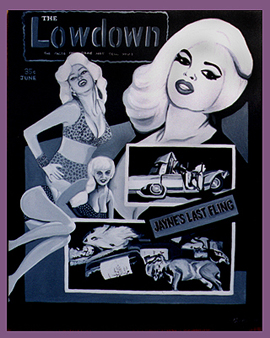 |
Though it really doesn't
make much difference, I was looking for a female artist
in Pop Art. Unfortunately, there were hardly any. And
absolutely none of great importance or influence.
However, the spirit of Pop art is still flourishing, and
there are several female artists in Vancouver creating
interesting work that is most definitely 'pop'. They call
themselves the 'Poptarts' and make a strong and sarcastic
use of comic and advertising images of women. Nicole Steen is one such artist. She describes her work by writing "I hung sheets of paper painted with glamour icons,Marlene Dietrich,Carole Lombard and Veronica Lake etc. "Paper Dolls" Later, I included paintings on cardboard of comic book heroines and b-movie dames in the display." This is especially reminiscent of the comic and icon influences in Pop art, and specifically of Roy Lichtenstein's comic-style pieces. |
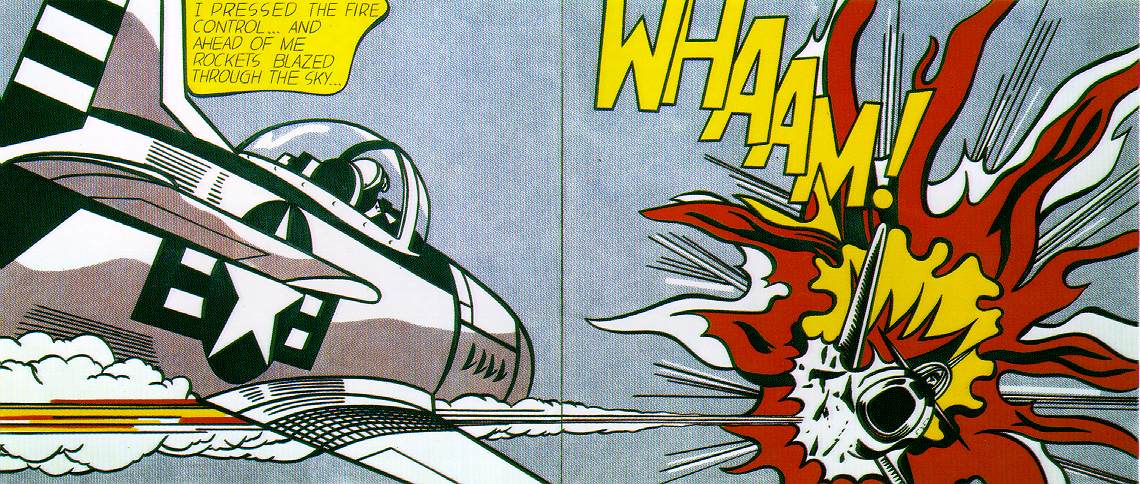 |
| Roy Lichtenstein, Whaam!
1963. Magna on canvas
|
Arthur Lipsett and Roy Lichtenstein chose very different mediums to create their art, but the similarities between the techniques they used and the effect that was generated are enormous. Both artists transformed popular forms of media and culture (film and news reels and comics) into sarcastic and insightful artistic creations.
Lipsett's film A Trip Down Memory Lane and Lichtenstein's Whaam! have many corresponding features. They both discredit the airforce and authority by creating a parody of its seriousness. Lipsett does this by juxtaposing images war and military with other cleverly chosen images. Lichtenstein ridicules the armed forces by reducing it to a comic. Both artists employ disjoint commentaries and images to create humour and irony. Lichtenstein writes an unbelievable caption that portrays the unseen pilot's ignorance and lack of remorse for his actions. Lipsett used a soundtrack of music or speech during the military scenes, but rarely used the authentic sounds.
The most interesting correspondence between the film and the painting is the near disaster they introduce. Much of Lipsett's film captures the ridiculous behaviour of humans and their propensity towards creating disasters and fatal accidents. Whaam! also depicts ridiculous human behaviour and the onset of a dangerous and likely fatal incident.
Sources
http://www.biddingtons.com/content/pedigreepop.html
http://www.warhol.org/collections/index.html
http://www.ecn.co.uk/PopArt/e_ed_pop_PopHistory.htm
http://www.mugu.com/cgi-bin/Upstream/People/Kimball/POP.html
http://www.latin-art.net/english/glosario.htm